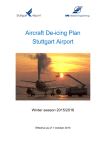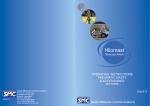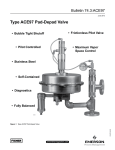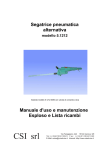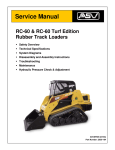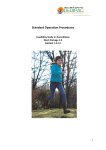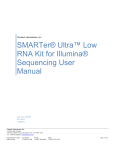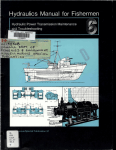Download 1" Air-Powered Diaphragm Pump - Series "
Transcript
LINCOLN Models 84852, 84853, 84855, 84856 1“AIR-POWERED DIAPHRAGM PUMP Series “B” OPERATING INSTRUCTIONS, SERVICE MANUAL AND REPAIR PARTS LIST the opposite inner chambers causing the diaphragms, which are connected by a shaft, to move endwise. Since air pressure is applied over the entire surface of the diaphragm which is forcing liquid to be discharged by its other side, the diaphragm is operating under a balanced condition during the discharge stroke. This allows the unit to be operated at discharge heads over 200 feet (61 meters) of water head. OPERATING AND SERVICE INSTRUCTIONS HAZARD POSSIBLE WARNING EXPLOSION HAZARD can result if 1,1,1, -Trichloroethane, Methylene Chloride or other Halogenated Hydrocarbon solvents are used in pressurized fluid systems having Aluminum or Galvanized wetted parts. Death, serious bodily injury and/or property damage could result. Consult with the factory if you have questions concerning Halogenated Hydrocarbon solvents. Alternate pressurizing and exhausting of the diaphragm chamber is performed by an externally mounted, pilotoperated, four way, spool type air distribution valve. When the spool is at one end of the valve body, inlet air pressure is connected to one diaphragm chamber and the other diaphragm chamber is connected to the exhaust. When the spool is moved to the opposite end of the valve body, the porting of chambers is reversed. The air distribution valve spool is moved from one end position to the other in the valve body by means of an internal pilot valve which alternately pressurizes the ends of the air distribution valve spool while simultaneously exhausting the other ends. The pilot valve is positively shifted at each end of the diaphragm stroke by the diaphragm plate’s coming in contact with the end of the pilot valve spool and pushing it into position for shifting of the air distribution valve. The chambers are manifolded together with a suction and discharge check valve for each chamber to maintain flow in one direction through the pump. INSTALLATION PROCEDURES Do not use for pumping flammable materials. Build up and discharge of static electricity may result in a fire and/or explosion causing personal injury and loss to property. Principle of Operation The pump is powered by compressed air which alternately pressurizes the inner sides of the two diaphragm chambers while simultaneously exhausting LINCOLN FEB-95 Position the pump as close as possible to the source of the liquid to be pumped. Avoid long or undersize suction lines and use the minimum number of fittings. gasket creep. Tighten loose securely to prevent leakage. fittings AIR SUPPLY Do not connect the unit to an air supply in excess of 125 PSI (8 61 bars). Install a shutoff valve in the air supply line to permit removal of the unit for servicing. When connecting an air supply of rigid piping, mount a section of flexible line to the pump to eliminate piping strain. In permanent installations, an air line filter IS recommended. The weight of the air supply line and of the filter must be supported by some means other than the air valve cap. Failure to provide support may result in damage to the pump. A pressure regulating valve should be installed to prevent pressure from exceeding recommended limits. OPERATION Your pump has been tested prior to shipment and is ready for use as received It is completely self-priming and no initial filling with fluid is required. If the unit is to be totally submerged, the air exhaust must be piped above liquid level to prevent the liquid and foreign material from entering the air distribution valve mechanism. Open the inlet air valve at least one turn to allow sufficient cycling rate for the pump to prime (30 to 60 cycles per minute). After pumping starts, adjust the inlet air valve for the desired pump ing capacity. When further opening of the inlet air valve increases cycling rate without increasing the flow rate, the pump is being starved of liquid due to suction limitations. Further opening of the air inlet valve will waste compressed air. Set the inlet air valve for lowest cycling rate that does not decrease flow rate for most efficient operation. For permanent installation involving rigid piping, install short flexible sections of hose between the pump and piping. This reduces strains and permits easier removal of the pump for service when required. At time of installation, inspect all external gasketed fasteners for looseness caused by Section - B5 Page - 15D FORM 402581 MAINTENANCE AFTER USE FREEZING OR ICING OF EXHAUST Icing of the air exhaust can occur under certain conditions of temperature and humidity on compressed air power equipment. When pump performance suffers because of icing, a nonsticky anti-freeze lubricant such as KILFROST, in an air line lubricator, will solve the problem. Icing is more likely to occur at high discharge pressures. If a diaphragm fails, the pumped product or fumes can enter the air side of the pump. This side is exhausted through the exhaust port (muffler). When the product is a hazardous or toxic material, the exhaust should be piped to. an appropriate area for safe disposition. When the product source is at a higher level than the pump (flooded suction), the exhaust should be piped to a higher level than the product to prevent spills caused by siphoning. Before maintenance or repair, shut off the compressed air line, bleed the pressure, and disconnect the air Iine from the pump. The discharge line may be pressurized and must be bled of its pressure. When the pump is used for toxic or aggressive fluids, it should be flushed clean prior to disassembly. When the pump is used for materials that tend to settle out or transform from liquid to solid form, care must be taken after each use or during idle time to remove them and flush the pump as required to prevent damage. In freezing temperatures the pump must be completely drained when idle. This model must be tilted to allow the liquid from the chambers to run out of the discharge port. DUAL PORTED MANIFOLD © Indicates Change SERVICE INSTRUCTIONS: TROUBLESHOOTING 1. Pump will not cycle A Check to make sure the unit has enough pressure to operate and that the air inlet valve IS open. B. Check the discharge line to insure that the discharge line is neither closed nor blocked. C. If the spool in the air distribution valve is not shifting, check the main spool. It must slide freely. D. Excessive air leakage in the pump can prevent cycling. This condition will be evident. Air leakage into the discharge line indicates a ruptured diaphragm. Air leakage from the exhaust port indicates leakage in the air distribution valve. See further service instructions. E. Blockage in the liquid chamber can impede movement of diaphragm. 2. Pump cycles but will not pump A. Suction side of pump pulling in air. Check the suction line for air leaks and be sure that the end of the suction line is submerged. Check flange bolting. Check valve flanges and manifold to chamber flange joints. B. Make certain the suction line or strainer is not plugged. Restriction at the suction IS indicated by a high vacuum reading when a vacuum gauge is installed in the suction line. C. Check valves may not be seating properly. To check remove the suction line and cover the suction port with your hand. If the unit does not pull a good suction (vacuum), the check valves should be inspected for proper seating. D. Static suction lift may be too high. Priming can be improved by elevating the suction and discharge lines higher than the check valves and pouring liquid into the unit through the suction inlet. When priming at high suction lifts or with long suction lines operate the pump at maximum cycle rate. 3. Low REPAIR KITS AVAILABLE performance A. Capacity is reduced as the discharge pressure increases, as indicated on the performance curve. Performance capability varies with available inlet air supply. Check air pressure at the pump inlet when the pump is operating to make certain that adequate air supply is maintained. B. Check vacuum at the pump suction. Capacity is reduced as vacuum increases. Reduced flow rate due to starved suction will be evident when cycle rate can be varied without change in capacity. This condition 86252 Air 86244 Hytrel End Wet Repair End 86245 Teflon Wet End 86237 Buns-N Wet Kit - All Models. Repair Repair End Repair SERVICE Kit - Models Kit- Model Kit- Model 84852 & 84856. 84853. 84855. PARTS Part Number Item No. 1 2 3 4 5 6 7 8 9 10 11 12 13 14 15 16 17 18 19 20 21 22 23 24 25 26 27 28 29 30 31 32 33 34 35 36 37 38 39 40 41 42 43 44 45 46 47 48 49 50 51 52 53 54 55 56 57 58 Description Body, spool valve Sleeve & spool set O-ring Cap, end Ring, retainer Cap, valve body Gasket Gasket Gasket Pilot valve assembly Capscrew, hex head Washer, flat Nut, square Capscrew, hex head Washer, flat Capscrew, hex head Bracket intermediate Chamber, diaphragm Chamber, diaphragm O-ring O-ring Bushing Ring, retainer Plunger, actuator Bumper Bearing, sleeve Seal, u-cup Nut, hex Washer, sealing Chamber, outer Ring, sealing Rod, diaphragm Bumper Plate, outer diaphragm Plate, inner diaphragm Diaphragm Capscrew, hex head Capscrew, hex head Ball retainer/cap O-ring O-ring O-ring Spacer, ring Ball, check valve Seat, check valve Capscrew, hex head Foot, mounting Capscrew, flat head Pipe plug Spring Diaphragm, overlay Muffler Stud Manifold Washer, flat (not shown) Washer, flat Manifold (Dual) Manifold N/A - Not Available (Nl) Fluorinated Qty. 1 1 8 2 2 1 1 1 1 1 1 15 1 4 4 14 1 1 1 2 2 2 2 2 2 2 2 8 2 2 2 1 2 2 2 2 8 4 4 4 4 4 4 4 4 8 2 4 1 1 2 1 2 1 4 4 1 1 240695 240696 240697 240698 240699 240700 N/A N/A N/A N/A 240706 240706 240707 240708 240708 240710 240711 240712 240713 240714 240655 240716 240717 N/A N/A 240720 240721 240722 240723 240724 240725 240726 240727 240728 240729 240730 240695 240696 (BN) 240697 240698 240699 240700 (BN) N/A (BN) N/A (BN) N/A N/A 240705 240706 240707 240708 240709 240710 240711 240712 240713 (BN) 240714 (BN) 240655 240716 240717 N/A N/A 240720 (Nl) 240721 240722 240723 240724 240725 240726 240727 240728 240729 (HY) 240730 240731 240732 240733 244191 244192 244193 ---- 240731 240732 240733 (BN) 240735 (BN) 240737 (BN) 240739 240750 240751 240752 240753 240709 ----- 240740 (HY) 240742 240743 240744 240745 240746 240747 240748 240749 240750 240751 240752 240753 240709 ----- 240752 240752 240741 240743 240744 240745 240746 240747 240748 ----- as a separate Nitrile, Model 84853 Model 84852 (BN) (BN) (BN) (BN) (HY) (TF) (TF) 240731 243564 240733 N/A N/A (Nl) (TF) (TF) (TF) item (see symbol (TF) Teflon, (HY) 240695 240696 240697 240698 240699 240700 N/A N/A N/A N/A 240705 240706 240707 243563 240709 240710 240711 240712 240713 240714 240655 240716 240717 N/A N/A 240720 240721 240722 240723 240724 240725 240726 240727 240726 240729 N/A (BN) (BN) Hytrel, Model 84856 Model 84855 N/A ---N/A 240743 240744 240745 240746 240747 240748 ---240750 240751 240752 240753 240709 ----- (BN) (BN) (BN) 240695 240696 240697 240698 240699 240700 N/A N/A N/A (BN) (BN) (BN) (BN) (BN) N/A 240705 240706 240707 240706 240708 240710 240711 240712 240713 240714 240655 (BN) (BN) (BN) (Nl) (BN) (BN) (BN) (Nl) (HY) (BN) (BN) (BN) 244193 ----- (BN) (BN) 240741 240743 240744 240745 240746 240747 240748 ----- (HY) 240750 240751 240752 240753 243566 243565 ----- 240752 for Repair (BN) 240716 240717 N/A N/A 240720 240721 240722 240723 240724 240725 240726 240727 240726 240729 240730 240731 240732 240733 244191 244192 (BN) Kit). Buna-N During reassembly make certain that the rubber bumper is on the rod on each side. install the diaphragm with the natural bulge outward as indicated on the diaphragm. Install the heavier plate on the outside of the diaphragm and make certain that the large radius side of both plates are toward the diaphragm. Place the sealing washer between the inner diaphragm plate and the end of the rod. Tighten the capscrew to approximately 25 ft. Ibs (3.456 kilograms/ meters). Torque while allowing the diaphragm to turn freely with plates. Use a wrench on the capscrew of the opposite side to keep rod from rotating. If the opposite chamber is assembled, the rod need not be held. will be more prevalent when pump ing viscous liquids. When pumping thick heavy materials the suction line must be kept as large in diameter and as short as possible, to keep suction loss minimal. C. Low flow rate and slow cycling rate indicate restricted flow through the discharge line. Low flow rate and fast cycling rate indicate restriction in suction line or air leakage into suction. D. Unstable cycling indicates improper check valve seating on one chamber. This condition is confirmed when unstable cycling repeats consistently on alternate exhausts. Cycling that is not consistently unstable may indicate partial exhaust restriction due to freezing and thawing of exhaust air. Use of an anti-freeze lubricant in an air line lubricator should solve this problem. When chambers securing chamber Need for inspection or service is usually indicated by poor priming, unstable cycling, reduced performance or the pump’s cycling but not pumping. Inspect the surfaces of both check valve and seat for wear or damage that could prevent proper sealing. If pump is to prime properly, valves must seat air tight. SERVICING Remove the eight nuts securing the outer diaphragm chamber flange and remove the chamber. Loosen the capscrew securing the diaphragm and plate to the rod by leaving the diaphragm engaged with the capscrews around the outer flange, preventing rotation of the rod. DO NOT USE A WRENCH ON THE DIAPHRAGM ROD. FLAWS ON THE SURFACE MAY DAMAGE BEARINGS AND SEAL. reassembling the outer and the manifold, the bolts the manifold flange to the should be snugged prior to The spool and sleeve are rust and corrosion resistant brass and hardened stainless steel. The spool is closely sized to the sleeve and should slide freely. Accumulation of dirt and oils may prevent the pump from cycling. Remove the valve body from the center pump housing, remove the end caps, and push the spool out of the sleeve. Wash the parts in cleaning solvent or kerosene, and check the spool and sleeve for possible roughness, nicks or scratches. Use a fine stone or crocus cloth to carefully remove any irregular marks on the surfaces. When the spool slides freely on the sleeve, coat the parts with light oil and reassemble. The four capscrews inserted through the valve body cap to hold the air valve to the intermediate section should be torqued to 150 in./lbs. (1.728 kilograms/meter). LINCOLN The Lincoln pump’s pilot valve and main air valve assemblies are designed to operate WITHOUT lubrication. This is the preferred mode of operation. There may be instances of personal preference, or poor quality air supplies when lubrication of the compressed air supply is required. The pump air system will operate with properly lubricated compressed air supplies. Proper lubrication of the compressed air supply would entail the use of an air line lubricator (available from Lincoln) set to deliver one drop of 10 wt, nondetergent oil for every 20 SCFM of air the pump consumed at its point of operation. Consult the pump’s published Performance Curve to determine this It is important to remember to inspect the sleeve and spool set routinely. It should move back and forth freely. This IS most important when the air supply is lubricated. If a Iubricator is used, oil accumulation will, overtime, collect any debris from the compressed air. This can prevent the pump from operating properly. This assembly is reached by removing the air distribution valve body from the pump and lifting the pilot valve out of the intermediate housing. Most problems with the pilot valve can be corrected by replacing the orings. Always grease the spool prior to replacement provides A Note about Air Valve Lubrication PILOT VALVE SERVICING RETAIN THIS INFORMATION ordering parts, a Distributor list: Part Number, Network ACTUATOR Bushings for the pilot valve actuators are held in the inner chambers with retaining rings. An o-ring IS behind each bushing. If the plunger has any sideways motion check o-rings and bushings for deterioration / wear. The plunger may be removed for inspection or replacement. First remove the air distribution valve body and the pilot valve body from the pump. The plungers can be located by looking into the intermediate. It may be necessary to use a fine piece of wire to pull them out, The bushing can be turned out through the inner chamber by removing the outer chamber assembly. Replace the bushings if pins have bent. AIR DISTRIBUTION VALVE SERVICING removing capWhether screws on suction or discharge valve retainer/cap, make sure all pressure on suction and discharge side of pump has been relieved. Re-lock wire the capscrews before continuing use. When PILOT VALVE SERVICING tightening the chamber bolts, to insure that the chamber port flange is square with the manifold flange. Finish tightening the manifold flange bolts after chamber bolting is secured. CHECK VALVE SERVICING DIAPHRAGM Inserting it into the sleeve. If the sleeve IS removed from the body, reinsertion must be at the chamfered side. Grease the o-rings to slide the sleeve into the valve body Securely insert the retaining ring around the sleeve. When reinserting the pilot valve, push both plungers (located inside the intermediate bracket) out of the path of the pilot valve spool ends to avoid damage, FOR FUTURE REFERENCE Description, that stocks Model equipment Number, and Series and replacement parts. Letter.






